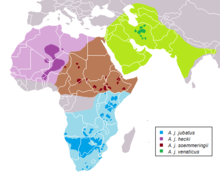| East African cheetah | |
|---|---|

| |
| A cheetah in Masai Mara, Kenya | |
| Scientific classification | |
| Domain: | Eukaryota |
| Kingdom: | Animalia |
| Phylum: | Chordata |
| Class: | Mammalia |
| Order: | Carnivora |
| Suborder: | Feliformia |
| Family: | Felidae |
| Subfamily: | Felinae |
| Genus: | Acinonyx |
| Species: | |
| Subspecies: | A. j. jubatus
|
| Trinomial name | |
| Acinonyx jubatus jubatus (Schreber, 1775)
| |

| |
| A. j. raineyi range (red) | |
| Synonyms | |
|
Acinonyx jubatus raineyi (Heller, 1913), A. j. ngorongorensis (Hilzheimer, 1913)[1] | |
The East African cheetah (Acinonyx jubatus jubatus), is a cheetah population in East Africa.[2] It lives in grasslands and savannas of Tanzania, Kenya, Uganda and Somalia. The cheetah inhabits mainly the Serengeti ecosystem, including Maasai Mara, and the Tsavo landscape.
A cheetah from British East Africa was described by the American zoologist Edmund Heller in 1913. He proposed the trinomen Felis jubatus raineyi as a distinct subspecies.[3] It also was recognized as several other distinct subspecies, such as A. j. ngorongorensis and A. j. velox.[1] In 2017, the Cat Classification Task Force of the Cat Specialist Group subsumed A. j. raineyi to A. j. jubatus.[2]
In 2007, the total number of cheetahs in East Africa were estimated at 1,960 to 2,572 adults and independent adolescents. East African cheetahs form the second-largest population after the Southern African cheetah. In 2007, there were between 569 and 1,007 cheetahs in Tanzania, between 710 and 793 cheetahs in Kenya, between 40 and 295 cheetahs in Uganda and approximately 200 left in Somalia.[4] Kenya is the main stronghold for the East African cheetah, with the largest population of 800 to 1,200 adults in the country since 2015.[5] In 2016, it was estimated that more than 1,000 individuals are resident in the Serengeti/Maasai Mara ecosystem of Tanzania and Kenya.[6]
Formerly widespread in East Africa, the East African cheetah lost a high percent of ranges and has gone extinct in three countries; the eastern Democratic Republic of the Congo (the North Kivu province and the South Kivu province), Rwanda and Burundi.[4]
- ^ a b Wozencraft, W. C. (2005). "Order Carnivora". In Wilson, D. E.; Reeder, D. M. (eds.). Mammal Species of the World: A Taxonomic and Geographic Reference (3rd ed.). Johns Hopkins University Press. p. 533. ISBN 978-0-8018-8221-0. OCLC 62265494.
- ^ a b Kitchener, A. C.; Breitenmoser-Würsten, C.; Eizirik, E.; Gentry, A.; Werdelin, L.; Wilting, A.; Yamaguchi, N.; Abramov, A. V.; Christiansen, P.; Driscoll, C.; Duckworth, J. W.; Johnson, W.; Luo, S.-J.; Meijaard, E.; O’Donoghue, P.; Sanderson, J.; Seymour, K.; Bruford, M.; Groves, C.; Hoffmann, M.; Nowell, K.; Timmons, Z.; Tobe, S. (2017). "A revised taxonomy of the Felidae: The final report of the Cat Classification Task Force of the IUCN Cat Specialist Group" (PDF). Cat News (Special Issue 11): 30−31.
- ^ Heller, E. (1913). "New races of carnivores and baboons from equatorial Africa and Abyssinia". Smithsonian Miscellaneous Collections. 61 (19): 1–12.
- ^ a b Durant, S.; Mitchell, N.; Ipavec, A.; Groom, R. (2015). "Acinonyx jubatus". IUCN Red List of Threatened Species. 2015: e.T219A50649567. doi:10.2305/IUCN.UK.2015-4.RLTS.T219A50649567.en. Retrieved 11 November 2021.
- ^ Cite error: The named reference
Kenyancheetahwas invoked but never defined (see the help page). - ^ Jason Daley (27 December 2016). "Cheetah Populations Plummet as They Race Toward Extinction". Smithsonian. Retrieved 30 December 2016.